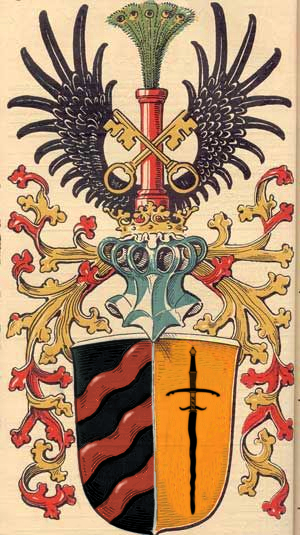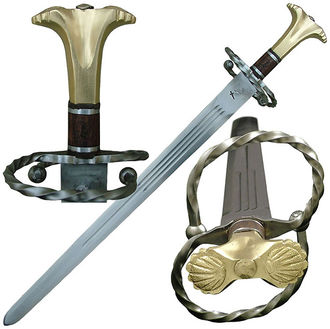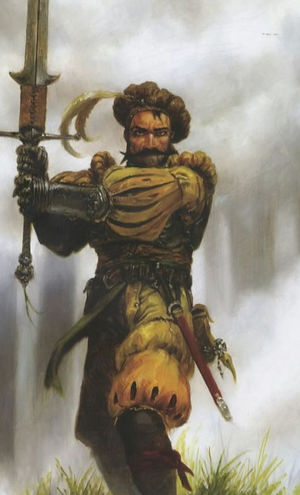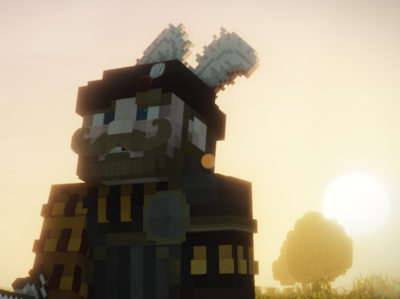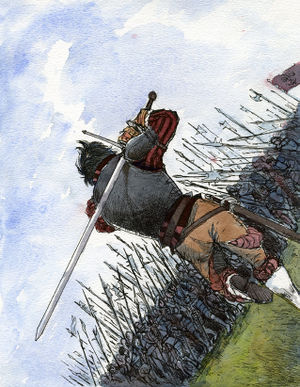Difference between revisions of "The Reichwald Greatswords"
(→Uniform and Insignia) |
|||
| (30 intermediate revisions by 3 users not shown) | |||
| Line 11: | Line 11: | ||
|<span style="font-size:small;">'''The Reichwald Greatswords''' | |<span style="font-size:small;">'''The Reichwald Greatswords''' | ||
|- | |- | ||
| − | |<span style="font-size:small;"> '''Active''': 1639- | + | |<span style="font-size:small;"> '''Active''': 1639-1657 |
|- | |- | ||
|<span style="font-size:small;"> '''Type''': Mercenary Free Company | |<span style="font-size:small;"> '''Type''': Mercenary Free Company | ||
| Line 49: | Line 49: | ||
The role of the Reichwald Greatswords | The role of the Reichwald Greatswords | ||
| − | is to provide quality greatsword infanteers to fulfill a contract of arms at home, abroad or on the field of battle. Each Doppelsoldner is | + | is to provide quality mercenary greatsword infanteers to fulfill a contract of arms at home, abroad or on the field of battle. Each Doppelsoldner is trained on the use of the Zweihander in battle, and the unit as a whole acts as the "Anvil" in hammer and anvil tactics. |
== History == | == History == | ||
| Line 55: | Line 55: | ||
'''Founding''' | '''Founding''' | ||
| − | The Reichwald Greatswords | + | The Reichwald Greatswords Mercenary Company was founded by Klaus von Krieger in the year 1638, when he was a single mercenary working for himself. After several people took interest in the landsknecht fashion of clothing he wore, Klaus founded the Reichwald Greatswords and opened up for recruitment. |
| − | == | + | == Organization == |
The Reichwald Greatswords don the flamboyant and wondrous puff-and-slash style garb of 15th-16h century German Landsknecht mercenaries. Their colours are Crimson, Gold and Black. | The Reichwald Greatswords don the flamboyant and wondrous puff-and-slash style garb of 15th-16h century German Landsknecht mercenaries. Their colours are Crimson, Gold and Black. | ||
| Line 65: | Line 65: | ||
'''Officers''' | '''Officers''' | ||
*Oberste (Colonel): A member or legitimized bastard of higher Nobility. | *Oberste (Colonel): A member or legitimized bastard of higher Nobility. | ||
| − | *Hauptmann (Captain): A member or bastard of gentry Nobility, | + | *Hauptmann (Captain): A member or bastard of gentry or higher Nobility, often related to the Oberste. |
*Leutnant (Lieutenant): Usually the highborn son or young cousin of the Oberste or Hauptmann in training to be the next Hauptmann and eventually Oberste. | *Leutnant (Lieutenant): Usually the highborn son or young cousin of the Oberste or Hauptmann in training to be the next Hauptmann and eventually Oberste. | ||
'''Enlisted Members''' | '''Enlisted Members''' | ||
| − | *Feldwaibel (Sergeant): The most senior Enlisted Member in the Regiment, in charge of dress, deportment and discipline. | + | *Feldwaibel (Sergeant): The most senior Enlisted Member in the Regiment, in charge of dress, deportment and discipline at Garrison and leads the men into battle while the officers stay behind. |
*Doppelsöldner: Literally meaning "Double-Pay Men" make up the rest of the Company as Greatsword soldiers - those who fight on the front lines ahead of pikemen and men-at-arms in order to destroy or disrupt the enemy vanguard. | *Doppelsöldner: Literally meaning "Double-Pay Men" make up the rest of the Company as Greatsword soldiers - those who fight on the front lines ahead of pikemen and men-at-arms in order to destroy or disrupt the enemy vanguard. | ||
| + | |||
| + | '''Tross''' | ||
| + | The "Baggage Train" of Camp Followers. | ||
| + | *Trossfrau or Kampfrau: Soldiers Spouses or Women who follow along. They perform camp upkeep tasks such as laundry, cleaning and cooking. | ||
| + | *Children: Children of the Soldiers or other men. | ||
| + | *Craftsmen: Tradesmen who offer blacksmithing, tailoring, leatherworking, or other services. | ||
| + | *Merchants: Barterers and Hawkers who sell and trade various goods. | ||
== Arms and Equipment == | == Arms and Equipment == | ||
| Line 97: | Line 104: | ||
== Operational History == | == Operational History == | ||
| − | '''The [[Battle of Rochdale]] 1640 | + | |
| − | + | '''The [[Third Crusade]]''' | |
| − | The Reichwald Greatswords, under the County of Chambery, fought with the Crusader forces and defeated Norland. The agreed upon payment for this was a shipment of | + | *The [[Battle of Rochdale]] 1640: |
| + | The Reichwald Greatswords, under the County of Chambery, fought with the Crusader forces and defeated Norland. The agreed upon payment for this was a shipment of 50 swords and 50 sets of armour. | ||
| + | |||
| + | *The [[Siege of Vjorhelm]] 1641: | ||
| + | In a final attempt to end Norland Paganism for good, the Crusader forces struck Norland's island city of Vjorhelm and stormed the fortress Krag. The resulting battle ended in an overwhelming victory, leaving nearly every Norlander dead or captured. | ||
== Battle Honours == | == Battle Honours == | ||
| − | The [[Battle of Rochdale]] 1640 | + | *The [[Battle of Rochdale]] 1640 |
| + | |||
| + | *The Rescue of Count Alexandre 1640 | ||
| − | The | + | *The Defense of [[Metz]] against [[Void]] Abominations 1641 |
| + | |||
| + | *The [[Siege of Vjorhelm]] 1641 | ||
== Lineage == | == Lineage == | ||
| Line 118: | Line 133: | ||
== Notable Members == | == Notable Members == | ||
| − | [[File:Klaus.png|thumb | + | [[File:Klaus.png|400px|thumb|left| Sergeant Klaus von Krieger c. 1640]] |
[[Category:Oren]] | [[Category:Oren]] | ||
| − | [[Category: | + | [[Category:Martial Organisations]] |
| + | |||
| + | [[File:Doppelsoldner.jpg|thumb||right| An artists rendition of a Doppelsoldner charging into pikemen and halberdiers c. 1641]] | ||
Latest revision as of 12:00, 31 January 2021
|
Role
The role of the Reichwald Greatswords is to provide quality mercenary greatsword infanteers to fulfill a contract of arms at home, abroad or on the field of battle. Each Doppelsoldner is trained on the use of the Zweihander in battle, and the unit as a whole acts as the "Anvil" in hammer and anvil tactics.
Contents
History
Founding
The Reichwald Greatswords Mercenary Company was founded by Klaus von Krieger in the year 1638, when he was a single mercenary working for himself. After several people took interest in the landsknecht fashion of clothing he wore, Klaus founded the Reichwald Greatswords and opened up for recruitment.
Organization
The Reichwald Greatswords don the flamboyant and wondrous puff-and-slash style garb of 15th-16h century German Landsknecht mercenaries. Their colours are Crimson, Gold and Black.
The Ranks in the unit are determined by a Doppelsoldner's leadership ability or social status, and fall under two categories: Officers and Enlisted Members.
Officers
- Oberste (Colonel): A member or legitimized bastard of higher Nobility.
- Hauptmann (Captain): A member or bastard of gentry or higher Nobility, often related to the Oberste.
- Leutnant (Lieutenant): Usually the highborn son or young cousin of the Oberste or Hauptmann in training to be the next Hauptmann and eventually Oberste.
Enlisted Members
- Feldwaibel (Sergeant): The most senior Enlisted Member in the Regiment, in charge of dress, deportment and discipline at Garrison and leads the men into battle while the officers stay behind.
- Doppelsöldner: Literally meaning "Double-Pay Men" make up the rest of the Company as Greatsword soldiers - those who fight on the front lines ahead of pikemen and men-at-arms in order to destroy or disrupt the enemy vanguard.
Tross The "Baggage Train" of Camp Followers.
- Trossfrau or Kampfrau: Soldiers Spouses or Women who follow along. They perform camp upkeep tasks such as laundry, cleaning and cooking.
- Children: Children of the Soldiers or other men.
- Craftsmen: Tradesmen who offer blacksmithing, tailoring, leatherworking, or other services.
- Merchants: Barterers and Hawkers who sell and trade various goods.
Arms and Equipment
The typical Reichwald Greatswords Landsknecht soldier would carry the following on a daily basis:
Arms:
- Zweihander greatsword: either the straight-edge or Flamberge variant.
- Katzbalger arming sword for close encounters or when a greatsword is too cumbersome. This type of sword is often worn without a sheathe for quick, disciplined use.
- Landsknecht Dagger: A triangular blade used for stabbing and puncturing chainmaille. The shape of the blade blade makes the wounds near impossible to stitch up with conventional medicine and requires a team of surgeons.
- Crossbow: A light crossbow is often used for ranged engagements.
Matchlock Arquebus: For specialized troops known as an Arquebusier - IF they're added to the lore.
Equipment:
- Waldenian "Maximilian" fluted plate cuirass, gorget, spaulders, tassets, knee cops, greaves, gauntlets and sabatons. Traditionally worn on just one side.
- Traditional Waldenian Tellerbarret or "Starfish Hat," often decorated with vivid colours or spectacular feathers.
- Coinpurse for gambling.
- Mess tin with a simple knife, fork and spoon.
- A pair of bone, wood or ivory dice for the Company's favourite game of Cretzer Craps.
- Belts.
- Leather Boots or traditional Landsknecht shoes.
- Hygiene supplies like moustache wax, soap, etc.
- Lorraine Cross.
- Whetstone.
Operational History
The Third Crusade
- The Battle of Rochdale 1640:
The Reichwald Greatswords, under the County of Chambery, fought with the Crusader forces and defeated Norland. The agreed upon payment for this was a shipment of 50 swords and 50 sets of armour.
- The Siege of Vjorhelm 1641:
In a final attempt to end Norland Paganism for good, the Crusader forces struck Norland's island city of Vjorhelm and stormed the fortress Krag. The resulting battle ended in an overwhelming victory, leaving nearly every Norlander dead or captured.
Battle Honours
- The Battle of Rochdale 1640
- The Rescue of Count Alexandre 1640
- The Siege of Vjorhelm 1641
Lineage
-Originated early 1640 as The Reichwald Greatswords
Commendations and Awards
None yet.
Foreign Relations
Canonist Affectionate, but Neutral.
Notable Members
